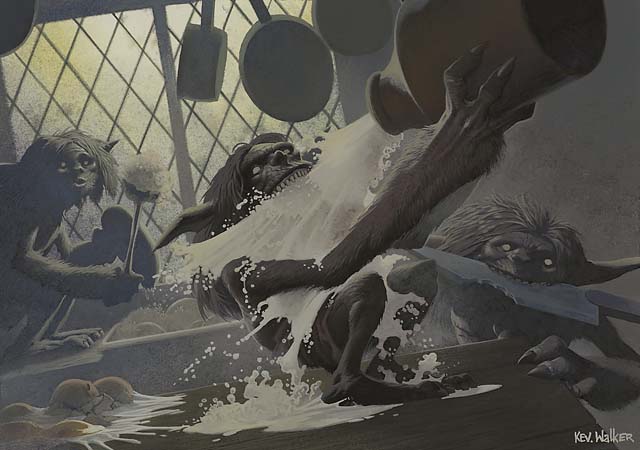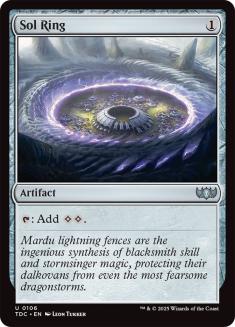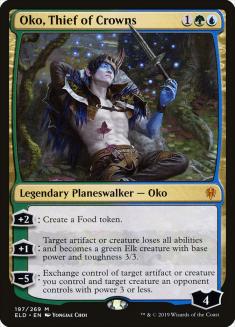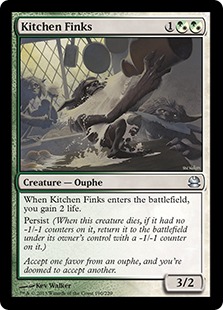Hello, and welcome to this edition of Sullivan’s Satchel. The biggest recent news from Wizards of the Coast (WotC) is the release of some Historic Jumpstart something-or-other with a ton of cards, most notably cards and keywords that tap into “digital only” space — changes that persist through zone changes or randomly generating cards among a subset. This represents, among other things, the first time WotC has released cards that are incompatible with paper play into a format with Organized Play support, whatever that means going forward.
I don’t have strong opinions here. Historic is clearly a sandbox for experimentation; it is wholly unconnected to traditional product releases, and that combined with the fact that it’s only available on Arena means that WotC can try all sorts of things here without spillover into other formats or products. Historic was already not for me for other reasons, but it has its following and if they enjoy stuff like this, great.
More importantly, I don’t think this release means they are beholden to mining this space in perpetuity. If it goes poorly or is received poorly, they can walk it back. If it’s a success, they can dial it up, and if the right frequency is somewhere in the middle, they can do that, too. More curious than anything else to see how it goes, but I’m already a step removed from the format; I don’t know how I’d feel if Historic was my primary mode of play. But this is a huge step even if it’s small, and the consequences could represent a significant change in Magic design if this goes well.
With that, the questions. As always, you can send in yours to [email protected] or DM me on Twitter @BasicMountain. I answer the choice selections, plus the best question gets the title of Question of the Week™, with its author receiving $25 in SCG credit, on top of my implicit approval (current retail value: $0.)
Going to do something a little different this time around. Friend of the Satchel™ Ben Seitzman always brings the heat. For various reasons I had to pass over his questions last week, meaning I have a deep reserve of thoughtful questions. So here it is, a Mostly Ben Seitzman Satchel. Readers, take heed — with enough dedication, this could be you.
For me, the biggest factor for “offensiveness” here is some algorithm that roughly equates to “wretchedness of play pattern multiplied by power level, with more sympathy for designs as they get older.” As an example, the fast mana in Alpha is extremely defensible, given the context. They’re actually fairly modest in low-power games, and the first set is full of cheap ways to defend oneself from an early Air Elemental or whatever people could do back then (Counterspell, Swords to Plowshares, etc.).
Also, they didn’t know much better, if not in an immediate sense, then in terms of how those cards would scale over time. That isn’t the easiest thing to figure out when you’re making a game this complicated for the first time. Mox Sapphire and Sol Ring facilitate a lot of variance and replayability that don’t just end the games by themselves; they need some sort of payout to pair with. I think they make excellent marquee cards for Magic’s oldest format.
All the opposite is true of Oko, Thief of Crowns, making it by a margin my least-favorite design on the Restricted List. It came out recently so “ignorance” is less plausible of an excuse, it makes the game extremely unfun just on its own, and it flattens out the range of all cards once its involved in the game, making the opposite of the type of volatility the fast mana produces. I can’t come up with a reasonable defense of this card, and I’m usually pretty good at such things.
I am. Usually I think the amount of discussion of trades and free agency decisions and such is a little derailing; the amount of coverage given to that versus to the actual games is not something I’m a big fan of. But I’m more interested this time. The Finals were a pretty big surprise versus preseason expectations, and that combined with the consensus “elite” teams in the NBA (Lakers, Nets, etc.) looking a little shaky means that I expect a bunch of teams to look to improve, instead of bottom out. I think the play-in tournament has helped to that end, as well.
I didn’t mind the Warriors’ recent dominance on its own terms as much as I minded how many teams didn’t look to compete for a title in the face of a team that good, and I appreciated Houston pushing their chips in at the time, even if they didn’t end up winning the West. I’m more interested in the league when as many teams as possible are trying to win games, and I expect next year to grade out really well on that scale.
As far as the Clippers go, they don’t have many cards to play. They’re in the luxury tax and trading picks is prohibitively complicated with their outstanding obligations to OKC. They basically have enough assets to cobble together a reasonable offer for an expensive, “distressed” asset (does Mann, their first-rounder, and matching salary get you in the conversation for Westbrook? Wall? Love? Do any of those players move the needle anyway?), and even that sort of deal gets complicated after next season, when the expiring deals for Beverly, Rondo, and Ibaka come off the books.
Still, Paul George and Kawhi Leonard is a lot, and even if next season is washed out while Kawhi rehabs, they should have a three-year window to legitimately compete for the title, assuming he re-signs and regains most of his previous form. This year’s playoff run was magical in its own way and if nothing else I’m ready to root for Paul George through the rest of his prime. I don’t think the Clippers come into next year as the favorite, but the same was true of the Bucks and Suns, and you can’t just treat 5% or 10% of title equity as a rounding error. I’d bet against them winning a title with this core after Kawhi’s injury, but stranger things have happened, and if nothing else I’m happy at this stage to root for a team that’s joyful to watch, even if they’re a bit short.
Honestly, this was the first year that I became aware of National New Jersey Day, and only through the official New Jersey Twitter account, which is pretty good as far as corporate accounts go. Our sense of self has never been predicated on national attention or approval and so it’s fine, I don’t have any hostility towards it, but it’s not something I’m going to celebrate, either.
I’m sensitive enough to play pattern considerations and hate pitching things I don’t believe in, so I do try to “visualize” it, in a sense, but maybe not in the way you’re describing. I usually run through an aggregation of scenarios that factor in things like:
- What is the range of counterplay that’s available?
- If this is on the battlefield for a few turns and someone peels an answer to it, how satisfying is it to play the game in its aftermath?
- How sensitive is it to a range of characteristics?
As an example of that, maybe Kitchen Finks is stronger than you’re supposed to do for Standard, but I really appreciate how much it cares about stuff. First strike, flying, and trample all have specific context against it, and various forms of removal line up better or worse against it, depending on details. If the card biases towards a later game, or control strategies, does it either allow for a satisfying game in its aftermath, or at least wins the game pretty quickly after it resolves? And on and on like that, until I think I’ve worked the design into something that I think “plays well,” and then proceed from there.
To clarify: not everything has to “play well” by conventional definitions. Having a range of experiences is important, and different play patterns at the right rates and frequency can enrich the experience. But it is rare for me to want to start there unless there’s some other goal(s) in mind.
I think these principles apply pretty broadly to TCGs in general (direct attacking games like Hearthstone are a little different), so there’s not a major distinction between Magic and Eternal as far as that process goes.
Lastly, the Question of the Week™, and winner of $25 in SCG credit, from Andy Hurst [planning something later on for Ben, Satcheler (?) of the Year]:
Loving the current Resleevables arc; I started playing competitively just after Judgment came out so I remember that era quite fondly, probably because as a beginner I was able to build UG Madness – a Tier 1 deck of the era if not the best – for like $30 total (including sleeves). There weren’t even any Rares specifically required, and the deck stomped.
As a new tournament player, this was a huge boon. However, from the perspective of a game designer, this seems like dropping the ball pretty hard. If the rares aren’t the exciting / important cards in the sets, I’d guess the packs don’t move nearly as well. What are your thoughts about the balance between having important, exciting rares that drive the sales vs accessibility for the newer / younger players to easily acquire the tools to compete?
Thanks for your time & consideration!
This is a great question, and something that designers struggle with constantly. In the U/G Madness example, I don’t think the issue is that specific deck being at that specific price point, though it isn’t ideal. So much of Magic and Standard specifically is the trickle-down effect to the local level, where players are often sensitive to price points in a way one doesn’t see on the SCG Tour or other more competitive events. At the local level, a deck that cheap and that good is likely to become more ubiquitous than is ideal, even if it isn’t the best thing to build in absolute terms.
During Caw-Blade Standard, I hung out at local stores a lot, and it struck me how much more of an issue Stoneforge Mystic was than Jace, The Mind Sculptor for this reason, which never would have clicked for me if I only engaged with Magic through the SCG Tour and Magic Online (MTGO) Leagues. But to whatever extent that is problematic, it is secondary to the bigger problem — Odyssey’s complete and total lack of appealing rares, either for competitive or casual play. The issues are a little related, but it’s important not to conflate them.
Rather than target “budget decks” like U/G Madness, I’ve found the higher yield to be trying to ensure a more even distribution of power among all the rarities. That isn’t easy to do, and decks composed of nothing but commons and uncommons are likely to be pretty boring, so this is no small task. But I think “most winning decks have a roughly even distribution of all rarities” is a better way to go about it than “we’ve made one competitive deck with no rares, and then all the other decks cost a ton of money.” Not only is this a more precise thing to target, it communicates something valuable — that rarity should speak to complexity and uniqueness more than power level in absolute terms.
I want to qualify all of this by saying this is nearly impossible to get completely right, too many considerations and too much chaos in the system, but I think it behooves designers to be broadly aware of how much power exists at each rarity within a set, and make efforts to ensure the set or format is neither too top- nor bottom-heavy.





